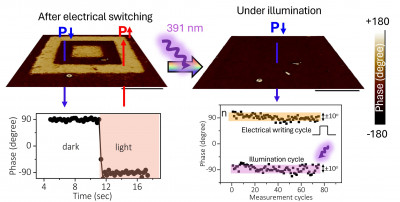News
Reversible ferroelectric polarisation: breakthrough in optical switching of ferroelectric domains paves way for next-gen memory devices
11 September 2025

An international team of researchers have made a groundbreaking advance in memory technology, achieving lightning-fast control of data storage using light. Their discovery, published in Nature Communications, shows that special freestanding materials can switch data states in under half a second when exposed to light – an astonishing 1,200 times quicker than current thin-film technologies. This breakthrough could revolutionise how we store and process information in future computing systems.
This breakthrough opens new possibilities for high-speed, energy-efficient optical memory devices, where light, rather than just electricity, could control data storage and computing. Such technology could lead to faster, more sustainable computing systems, including neuromorphic networks and wireless optical sensors.
Ferroelectric materials, which retain electrical polarisation even without power, are crucial for next-generation memory and computing. But traditional electrical switching has limitations in speed and energy efficiency. Optical control using light to manipulate domains offers a major step closer to speeds required for practical use.
Dr Subhajit Pal and Professor Joe Briscoe at Queen Mary University of London have now overcome this barrier. Their work shows that freestanding BTO membranes, free from the constraints of a rigid substrate, enable subsecond optical switching – a game-changer for future optoelectronic devices.
"What’s exciting is that we’ve not only achieved ultrafast switching but also demonstrated its robustness," says Professor Briscoe. "The system shows no fatigue even after repeated cycles, meaning it’s not just fast, it’s reliable."
Key to this breakthrough is the unique behaviour of freestanding ferroelectric films. Unlike clamped thin films, which are hindered by substrate-induced strain, freestanding membranes allow domains to move more freely. When illuminated, light reduces the energy barrier for domain wall motion, while an intrinsic imprint effect (a built-in bias voltage) further accelerates polarisation reversal.
To confirm the mechanism, the team collaborated with Professor Anna Grünebohm’s group at Ruhr-University Bochum, Germany, whose molecular dynamics simulations matched experimental observations perfectly.
"The simulations revealed why freestanding films respond so much faster removing the substrate unlocks domain mobility," explains Dr Pal. "It’s a beautiful example of theory and experiment converging to explain a groundbreaking result."
The path to discovery wasn’t straightforward. Dr Pal initially faced setbacks when early attempts to study photovoltaic effects in ferroelectric crystals yielded unclear results. But a sudden insight – testing optical switching on freestanding BTO membranes, led to the pivotal breakthrough.
"This work proves that next-generation memory technology isn’t just a dream - it’s within reach," says Professor Briscoe. "With optical control, we’re looking at a future where computing is faster, more efficient, and even more versatile."
| Contact: | Prof Joe Briscoe |
| Email: | j.briscoe@qmul.ac.uk |
| Website: | |
| People: | Joe BRISCOE Subhajit PAL |




